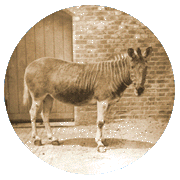|
|
|
The Zebra |
|
| |
|
|
|
|
|
|
|
|
|
|
The Zebra |
|
| |
|
|
|
|
|
|
|
The Plains Zebra
This zebra is also known as Burchell's zebra, common zebra, and Bontequagga. "Bontequagga" is the Boer name of the fully striped zebra, meaning "brightly striped quagga." There is much confusion about this species. Some believe that, the plains zebra was the quagga, while others argue that the first true plains zebra was the Burchell's zebra of South Africa. There are also many subspecies in this group as well to add further confusion to the picture. These zebras are found feeding on the rich grassland of eastern and southern Africa.
Plains zebras are about pony size, measuring about 12 hh, sometimes more. The plains zebra is lighter boned than any other zebra, with a fine, supple neck and nicely formed legs. It has a fairly heavy head that is blunt when viewed from the side, and its ears are early horse-sized. Its base coat color ranges from buff to white, while stripes may be any shade of dark brown to black, and sometimes alternate with shadow stripes which are paler. Its stripes are broad and widely spaced over the entire body, and extend down to the coronet on most animals. Some animals tend to have faded or missing stripes on the legs and underline, especially those in the southern regions.
Since the plains zebra is the most common, it also has been the most thoroughly studied. They are a good example of Type 1 behavior and breed all year-round, though more than 75% of the births occur between October and April. They have an average lifespan of 15 years. These zebras have been broken to harness with fair results, perform liberty acts and even pull floats and carts in parades. They do require a constant watch, and are stubborn, untrustworthy and tire quickly. There is so much variety in the striping within this group that over 20 subspecies have been described, and often animals typical of different subspecies could be found in the same herd.
 The selection of subspecies was narrowed down to four in 1936, making identification much easier. Burchell's zebra was named for the British explorer and naturalist William John Burchell, who first described this zebra. This subspecies is thought to have become extinct since 1910, and it once roamed in the Orange Free State and in southern Botswana. Its legs had no striping, although some may have had a faint tracing just above the hock. Shadow stripes were generally present.
The selection of subspecies was narrowed down to four in 1936, making identification much easier. Burchell's zebra was named for the British explorer and naturalist William John Burchell, who first described this zebra. This subspecies is thought to have become extinct since 1910, and it once roamed in the Orange Free State and in southern Botswana. Its legs had no striping, although some may have had a faint tracing just above the hock. Shadow stripes were generally present.
The Damara, or Chapman's, zebra has some striping on the legs, but is never completely marked to the hoof. Stripes were dark brown with shadow stripes generally present in the buff color. The Damara zebras roam in southern Angola, Benguela and Damaraland across Botswana to Transvaal and Zululand. Selous' zebra has legs that are completely striped to the hoofs. Shadow stripes are generally absent or very few, and stripes and interspaces on neck and body are narrow and numerous. This zebra is found from the former county of Rhodesia and Mozambique north to southern Malawi.
Boehmas zebra is also known as Grant's or East African zebra, and is smallest of the plains zebras. This zebra also has legs striped completely to the hooves, and is generally without shadow stripes. neck stripes are wider and less numerous that Selous' zebra. Pure black and white stripe colors are usual. You could find this zebra throughout Zambia, Kenya, Uganda, southern Ethiopia and southwest Somalia.
For more information, visit:

|
© 1997-2007
NW Breyer Horse Club & Refiner of Gold Creations Equinealities in place since 1997, Section in place 2001, Updated 3/13/2007 |



|
| ||

|
|||||